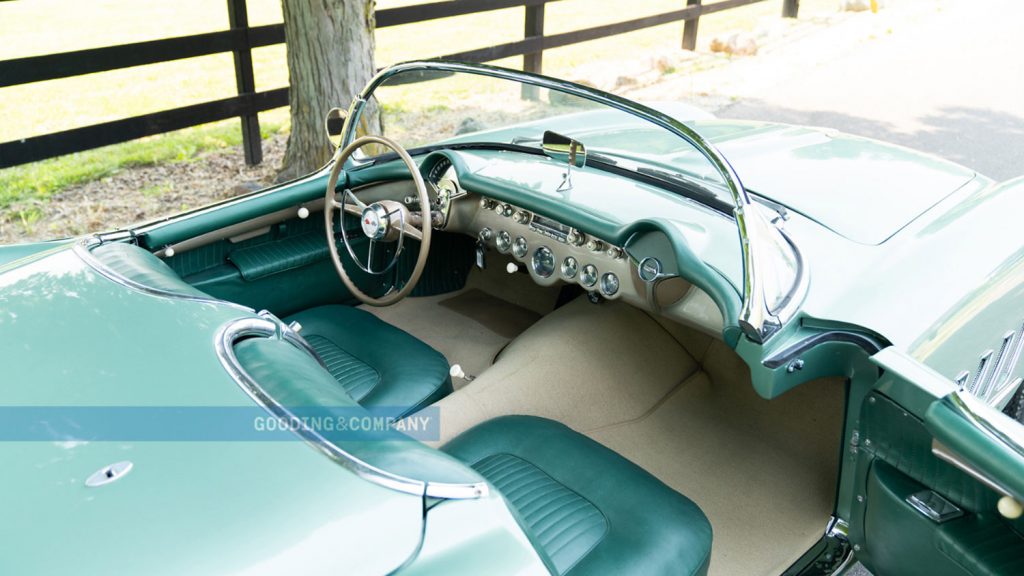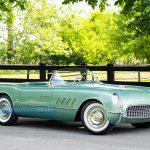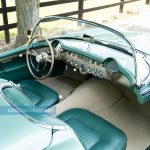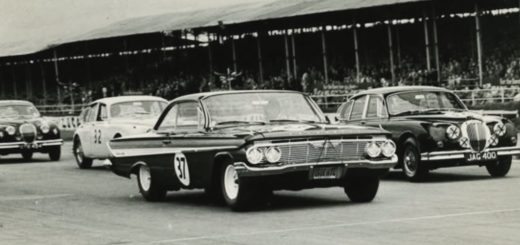Before the Chevy Corvette had been approved to become a full production car for the 1953 model year, it appeared as a GM Motorama show car. Fifteen fiberglass bodies were laid by hand. These single-piece bodies came with internal GM codes indicating their use. The first-ever prototype shown at the New York Waldorf Astoria in January 1953 carried the code EX-52. Others had placards with Shop Orders, or S.O. numbers, indicating that they were 1954 Motorama cars. Most of the show cars didn’t survive intact, but were used, either in part or in whole, for other projects, while others were disassembled or destroyed.
Our feature 1954 Chevy Corvette was one of those original fifteen hand-laid, single-piece fiberglass bodies. Wearing a placard that bears S.O. 2151, it began life as a pale yellow prototype hardtop that was part of the 1954 GM Motorama, designated S.O. 2000. After its initial service, it was reborn S.O. 2151, and would become a Proposal Car for 1955 Corvette design under the watchful eye of Harley Earl.
S.O. 2151 was sent to General Motors’ Art and Color department to be reborn with new design elements as suggestions for the 1955 Chevy Corvette. It received a modified Bel Air grille, exhaust tips that exited through the rear bumperettes rather than from the body, a redesigned trunk lid that took cues from the 1953 Motorama Corvair with stamped Chevy Bow Ties in the bright trim panel around the license plate, forward-slanted vents in the front fenders (the driver side vents were chrome, the passenger side half-chrome, half-painted), and horizontal side trim (again, chrome on one side, painted on the other), and Corvette script on both sides, one side mounted low near the horizontal trim, the other side higher. The “V” in the Corvette script was oversized and gold, indicating the availability of a V8 for the 1955 model year. The different details were designed to give the GM executives choices. S.O. 2151 was repainted in an attractive Bermuda Green metallic.
The Chevy Corvette prototype was placed atop a 1954 Corvette chassis. An experimental inline six with a solid-lifter performance cam and three Carter sidedraft carbs powered the Corvette.
Almost none of the features on S.O. 2151 made it into production. The enlarged “V” appeared in the Chevrolet script on V8-powered 1955 Corvettes (seven of the 700 Corvettes built for 1955 were powered by the Blue Flame Six, the rest were 265 cubic-inch V8s). The 1955 Corvette was otherwise unchanged from the 1954s. The Corvette looked doomed, but was saved by a Ford. The 1955 Ford Thunderbird outsold the Corvette by a wide margin. Chevy executives elected to give the Corvette a complete facelift for the 1956 model year.
Somehow, our feature Chevy Corvette escaped the fate of most prototypes and show cars, finding its way into private ownership rather than being destroyed. The history is foggy, but S.O. 2151 popped up at a San Jose, California dealership in 1963. Empire Chevrolet owner and Corvette collector Richard Oldham bought the car in 1974, but it was a project at best. Most of the paint was gone, as were most of the prototype design features. The fender vents were still on the car, as was the engine, transmission, and S.O. 2151 placard. Mr. Oldham placed an ad in Hemmings Motor News the following year, with an asking price of $3,000. The ad caught George F. Campbell’s eye. Mr. Campbell, on the advice of his friend and renowned Corvette expert Noland Adams, bought S.O. 2151.
For decades after his purchase, Mr. Campbell researched the Chevy Corvette’s history, collected what parts he could find, and dreamed of having the car restored. Unfortunately, he passed before it could be done. S.O. 2151 was acquired by Billy Jay Espich, an accomplished auto restorer based in Indiana with over 45 years of experience in the restoration business. The restoration took three years and 1,800 hours, with extensive research involved. Mr. Espich claims the Corvette has been his most challenging restoration, saying it is his “magnum opus.”
This piece of Chevy Corvette history will cross the Gooding & Company Pebble Beach Auction block taking place August 18th and 19th, with an expected hammer price of $1,500,000 to $2,000,000.
Subscribe to GM Authority for more Corvette news, Chevrolet news, and around-the-clock GM news coverage.





































Comments
wow wow wow finally a beautiful car at GMA … and in green …
My buddy knows this guy and told me last year that he was working on one of the most rare American cars ever, but we didn’t know what it was. Obviously it was a huge secret, now we know, very cool and a fellow Hoosier.
I’ve read that, sadly, the original Motorama Corvette, which was a static display model only, was consumed at the GM Proving Grounds in a fire set to see what flames did to fiberglass. Glad this one survived.
That sort of thing happens more than you’ll ever know.
and to think EV’s of today burn up by themselves.
It’s automatic. One of those features no one asked for.
Actually the Motorama car survived and is fully restored and owned by the largest Corvette dealer in the country.
Some others were burned and there were more than one Motorama cars. But the first running prototype is still around.
If the car he owns runs, it’s not the one I saw in a corner of the Chevrolet exhibit at the Waldorf Hotel in NY in January, 1953. That car was a “pushmobile,” as the designers say. Perhaps runners were shown as the Motorama made its way to other cities and he’s got one, or the first. of those. It would seem likely that a non-runner would be destroyed if only to check the flammability of fiberglass.
It’s good to know that they are auto restores like Billy Jay Espich. Who bring these masterpieces back to life so that we can enjoy them. Even if it’s only in pictures. What a beauty.
I read a story on this car being restored last year. It was amazing the amount of work it took. Researching info was difficult.
Sure looks like the passenger side of the grill sits higher than the driver’s side.